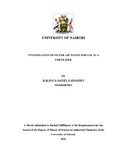| dc.description.abstract | v
ABSTRACT
One of the main brewers in Kenya is East African Breweries Limited (EABL) and it produces a lot of high organic load wastes. Most of these wastes have alternative uses except the diatomaceous earth filtration waste which represents a major challenge to the brewer. This project set out to investigate the use of the filter aid waste as a fertilizer that could be used by local farmers. The waste at various stages of deposition (fresh slurry to 1 year) was characterized. Characterization for all the deposition wastes revealed that the filtration waste could be used as a fertilizer either on its own or as a blend. The 1 year sample that was eventually chosen for further tests had an N, P, K, Ca and Mg content of 5300 ppm, 390 ppm, 1540 ppm, 89 ppm and 85 ppm respectively. The wastes had low compositional values as compared to other commonly used organic fertilizers. The waste on its own along with other blends was investigated for use as a fertilizer. A field test to check for the efficiency of the filtration waste was done using pure breeds of potatoes (Asante variety potatoes, Solanum tuberosum). Six plastic bags were separately loaded with soil containing unused filter aid (blank), filter aid waste, cow dung, goat droppings, blood meal, bone meal. Four other bags were each loaded with soil containing a mixture of the filter aid waste and the other four wastes (dung, blood, goat, bone). Monthly leaf uptake analysis, pre- and post-harvest soil and tuber analysis were conducted on the potatoes to investigate the viability of the various blends. The tests revealed that the uptake trends in all the bags showed a healthy uptake of the nutrients except for the levels of Zn in the plain soil and the filter aid waste bag. Post-harvest soil analysis was done so as to compare the nutrient levels in the top soil of the bags to pre-harvest compositions. Tuber analysis revealed that all the bags gave a healthy harvest without any obvious signs of deficiency visible. Due to the difficulties of classifying yield, this project came up with yield performance indices, for both chemical and physical parameters, so as to ably compare and express the yield of the potatoes. Physical parameters indicated that blending gave higher yield performance indices with the Goat Blend and Goat Droppings having a 70% and 32% index respectively. Chemical parameters for the same two bags however indicated that blending did not necessarily increase yield quality with Goat Droppings and Goat Blend having 65.56% and 72.22% respectively. Based on the physical yield parameters such as tuber size and weight of potato harvest, blending of the filter aid waste with other organic fertilizers resulted in better performance of the crop. | en_US |



